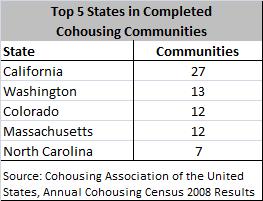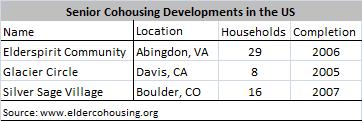What is cohousing?Cohousing is a form of residential development that is designed to emphasize community interaction while still retaining and respecting individual privacy. The close-knit nature that characterizes many cohousing communities affords older adults the freedom to live independently among friends who believe in active "neighboring"
and who look out for one another. Because of these and other features described below, senior cohousing communities provide a residential setting that can forestall or prevent a move to an assisted living residence and allow residents to age in place as their needs change.
First pioneered in Denmark in the early 1970s, the first cohousing community in the United States was not completed until 1991. [1] Although each community is unique, there is a set of principles that most cohousing communities share, including: resident involvement in the planning process; a common house and other facilities and land owned jointly; a physical layout that encourages interaction (e.g., individual homes clustered around the common house); and collaborative community management. [2]
| 
|
The roughly 115 inter-generational cohousing communities in the U.S. include nearly 2,700 households and are distributed across 23 states; the distribution, however, is uneven, with the majority located in the West. [
3]
The size of these communities varies considerably, but somewhere between 15-35 households is thought to be ideal for preserving close social ties. [
4]
Housing units average 1,250 square feet - typically smaller than traditional units - and can be single-family detached, townhomes, or condominiums, owned or rented, depending on the wants and needs of the residents.
[
5] When owned, as is often the case, the real estate structure is generally that of a condominium or planned-unit development, in which individual units are owned by the household and the community shares ownership of common facilities and common land through a homeowners' association. [
6]
In the U.S., cohousing originated as a self-development model in which individuals and families interested in creating a community initiated the planning process, which can take several years. More recently, cohousing professionals have streamlined the process by finding and marketing potential sites while still involving future residents in the planning process. Along with the egalitarian way in which the community is managed, this upfront planning imbues cohousing residents with a sense of autonomy and independence and creates what some call an "intentional neighborhood." [
7]
Because the physical layout and management structure encourage social interaction, cohousing appeals to those who wish to feel like part of a community. Opportunities to socialize over meals in the common house, to garden or landscape, to carpool, or to babysit are plentiful and provide a welcome alternative to the anonymity and alienation that some feel are the norm in many contemporary residential settings. [
8]
What is senior cohousing?Nearly all cohousing communities in the U.S. are intergenerational, open to families of all kinds and individuals of all ages. However, three existing communities and several more in the planning stages are specifically for adults over the age of 50 or 55. These senior or elder cohousing developments are a twist on the standard cohousing model, incorporating all of the principles of the intergenerational model but with features specifically geared toward accommodating the needs of older adults. Senior cohousing units generally embrace
universal design elements, and communities have accessible common areas.
[
9] Units themselves are often smaller, with some as small as 800-900 square feet, and guest rooms in the common house can accommodate visiting family or be used as studio apartments for live-in caregivers. [
10]

Apart from the physical design, senior cohousing communities deviate from their intergenerational counterparts in that residents define their collective approach to aging in community, including the limits of "co-care" that they are willing to provide to one another. These responsibilities, which are often defined early in the planning process and codified in the community bylaws, are commonly limited to activities like shopping, meal preparation, and housework but do not extend to activities like bathing and dressing.
[
11]
What are the advantages of cohousing for older adults?Whether living in an intergenerational or age-restricted cohousing community, older adults can benefit both socially and economically from the many opportunities to gather together, trade favors, and look after one another that this residential arrangement encourages. [
12]
Perhaps most importantly, senior cohousing allows residents to live independently and avoid institutional care for longer than might be possible in many conventional single-family neighborhoods. Suites in the common house can be made available to one or more live-in caregivers, who are compensated by residents in need of a higher level of care than their neighbors can provide. In addition to the convenience of living onsite, this arrangement facilitates the integration of the caregiver into the community, which may foster a more personal relationship with residents and improve quality of care. [
13]
Whether pooling money for a live-in caregiver, housekeeping, or a van and driver, older adults with the financial resources to do so can have essential services delivered onsite rather than in an institutional setting. [
14]
If a more acute medical situation arises that requires a higher level of care than can be provided long-term by the community, cohousing neighbors can assist a friend in need by providing "carry-over care" until permanent arrangements can be made. [
15]
Although the cost of a cohousing unit is often on par with or slightly higher than comparable housing units in the vicinity, the cohousing model does offer some cost savings. Smaller units require less maintenance, lower utility costs, and leave a smaller environmental footprint. Residents can also save money by sharing meals, amenities, and transportation. [
16]
In addition, many cohousing communities occupy urban infill sites, which can further lower transportation costs and improve access to important destinations like the hospital, grocery store, and post office. [
17]
 Learn more about cohousing's challenges and steps that can be taken to expand the supply of senior cohousing Learn more about cohousing's challenges and steps that can be taken to expand the supply of senior cohousing
 Go back to learn about other housing models geared to older adults Go back to learn about other housing models geared to older adults
|
[1] Senior Cohousing: A Community Approach to Independent Living - the Handbook. 2005. By Charles Durrett. Berkeley, CA: Habitat Press; Elder Cohousing Network.
[2] See: Cohousing Association of the United States.
[3] Annual Cohousing Census 2008 Results. Presentation by Betsy Morris and Craig Ragland at the Cohousing Association of the United States at the 2008 National Cohousing Conference.
[4] See: Elder Cohousing Network's Media Toolkit.
[5] Senior Cohousing: A Community Approach to Independent Living - the Handbook. 2005. By Charles Durrett. [6] See: Elder Cohousing Network's Media Toolkit.
[7] Ibid.
[8]"The Cohousing Approach to "Lifetime Neighbourhoods." 2008. By Maria Brenton. Factsheet No. 29, Housing Learning and Improvement Network.
[9] See: Cohousing Association of the United States.
[10] Senior Cohousing: A Community Approach to Independent Living - the Handbook. 2005. By Charles Durrett. [11] Ibid.
[12] "The Cohousing Approach to "Lifetime Neighbourhoods.'" 2008.
[13] Senior Cohousing: A Community Approach to Independent Living - the Handbook. 2005. By Charles Durrett. [14] Senior Cohousing: A New Kind of Housing for Aging Americans Starts to Catch On. 2008. San Francisco, CA: Bay Area Summit.
[15] Senior Cohousing: A Community Approach to Independent Living - the Handbook. 2005. By Charles Durrett. [16] See: Elder Cohousing Network's Media Toolkit; Communes for Grownups. 2004. By Ben Brown. AARP Bulletin Today. Washington, DC: AARP.
[17] See: Elder Cohousing Network's Media Toolkit; "The Cohousing Approach to "Lifetime Neighbourhoods.'" 2008; Annual Cohousing Census 2008 Results.
The views expressed herein are for information, debate and discussion, and do not necessarily represent official policies of AARP.


 Learn more about cohousing's challenges and steps that can be taken to expand the supply of senior cohousing
Learn more about cohousing's challenges and steps that can be taken to expand the supply of senior cohousing Go back to learn about other housing models geared to older adults
Go back to learn about other housing models geared to older adults